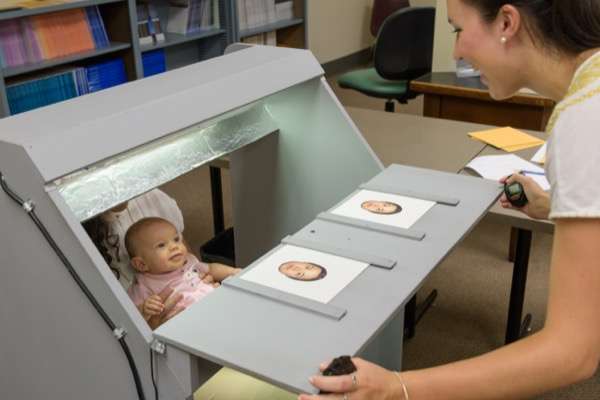New research finds a way to reverse children's racial stereotyping

New research by a University of Delaware psychological scientist and his collaborators across the globe has found a simple exercise that can undo the unconscious racial biases that young children have—biases that may begin to develop as early as infancy.
The findings are part of an ongoing, multi-country collaboration that has been conducted by Paul Quinn, professor of psychological and brain sciences at UD, for more than a decade. Funded by a National Institutes of Health (NIH) grant, Quinn works with researchers in Canada, France and China to explore how infants mentally classify faces by race and gender. This research has recently received attention in the New York Times and the Guardian.
Using an established technique of measuring how much time the babies spend looking at pictures of faces, Quinn has learned that 3-month-olds begin showing a visual preference for the categories—generally, female and the same race as themselves—that they see most often in their daily lives.
By 9 months of age, infants not only distinguish racial categories but also become less able to tell different individuals apart if they are members of a less-familiar race. For example, Caucasian infants can identify Caucasian faces as belonging to different individuals, but they are less likely to see Asian or African faces as distinct individuals.
"Our original thinking about the 9-month-old findings was that this process that we call 'narrowing' is based on visual perception, not any social bias," Quinn said. "But then the question we asked was: Might these perceptual biases we see in infants be related to the social biases that we see in older kids, beginning at 3 or 4 years of age, and adults?
"And if they are, can we use a technique to reduce bias? As we tried to answer this question, we hit on the idea that if the perceptual and social biases are linked, we might be able to reduce the social bias by perceptual means."
In this new study, published in July in the journal Developmental Science, Quinn and his collaborators in China used photos of African and Asian faces and morphed them together to create ambiguous images that looked equally African and Asian. Some of the faces had pleasant expressions, while others looked more severe.
When researchers showed the images to 4- to 6-year-olds in China, the children identified the happy faces as Asian—the category they were used to seeing—and the angry faces as African, a group they rarely saw in daily life.
The scientists' next step was to see whether the children's unconscious racial biases could be disrupted. They showed the youngsters five different African faces and gave each of the individuals a name, repeating the process until the children could identify each of the five faces by name.
When the children then looked at the happy and angry ambiguous-race photos again, their bias in favor of their own racial group had dropped significantly.
"This process of getting the kids to respond to the [five African] faces as individuals, not as a category, only takes 15-30 minutes, and it made a significant difference," Quinn said. "It suggests that what is a social bias has [visual] perceptual components and that it can be disrupted."
Many questions remain for further study, he said. Among them: After children go through the face-identification exercise and reduce their unconscious bias, how long does that effect last? Also, what aspect of the training is the critical ingredient? Is it mere exposure, or is it the act of individuation?
"This has caused us to rethink what's going on" in the link between perception and social bias, Quinn said. "There are a number of avenues we want to explore."
Research continues on infant perception
Another, related study that Quinn conducted in his lab at UD with babies from the Newark, Delaware, area has been published online by Developmental Science, with print publication expected in the future.
In this study, researchers worked with Caucasian babies to explore how and at what ages they began forming categories of people based on the racial characteristics of faces.
At 6 months, Quinn said, the infants were classifying faces into three groups—Caucasian, African and Asian. But just a few months later, they had grouped the African and Asian faces together into a single category.
"This was the surprise finding," Quinn said. "At 9 months, they didn't respond to the differences between the African and Asian categories, but instead they had two broad categories, 'own race' and 'other race.'
"It doesn't seem to matter to a Caucasian infant who has seen mostly Caucasian faces if a face is African or Asian. They only care that it's not Caucasian. We think it might be a precursor to an initial 'in group-out group' differentiation of faces.
"This result suggests that perceptual and social processing of faces may overlap even in infants."
Again, the findings suggest other issues to explore. A current study is investigating whether infants have positive associations with faces of their own, familiar race and more negative associations with less familiar faces from other races.
All the research that Quinn and his collaborators have been conducting since their initial NIH grant in 2004 centers on category formation—a basic cognitive process in which very young babies begin mentally classifying objects and animals in a way that, for example, sets apart squares from triangles and cats from dogs. Extending that research to faces led to the findings that infants also categorize images of people by gender and race.
More information: "Individuation training with other-race faces reduces preschoolers' implicit racial bias: a link between perceptual and social representation of faces in children." Developmental Science, 18: 655–663. doi: 10.1111/desc.12241


















